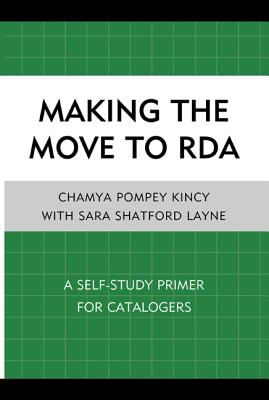Making the Move to RDA: A Self-Study Primer for Catalogers is aimed at catalogers working in the MARC environment who currently create records using AACR2 and need to transition to using the new standard, Resource Description and Access (RDA). Since both RDA’s structure and content differ from AACR2 in many respects, this primer details the development and rationale for RDA as well as its intended goals, principles, and objectives. It then explains RDA’s theoretical underpinnings—collectively known as the FRBR Family of Models.Framing the text along these lines provides readers the context for understanding the similarities and differences between AACR2 and RDA, both in terms of content and structure. With this foundation in place, the book takes the reader on a survey of RDA elements used to describe bibliographic and authority records and demonstrates how the MARC code has been expanded to accommodate new elements. Finally, it leads the reader field-by-field through MARC bibliographic records for book and non-book resources as well as through authority records for works, expressions, persons, families, and corporate bodies, describing the similarities and differences between AACR2 and RDA for each field.Examples are provided throughout the text to help the reader visualize the concepts presented.
Making the Move to RDA: A Self-Study Primer for Catalogers is aimed at catalogers working in the MARC environment who currently create records using AACR2 and need to transition to using the new standard, Resource Description and Access (RDA). Since both RDA’s structure and content differ from AACR2 in many respects, this primer details the development and rationale for RDA as well as its intended goals, principles, and objectives. It then explains RDA’s theoretical underpinnings—collectively known as the FRBR Family of Models. Framing the text along these lines provides readers the context for understanding the similarities and differences between AACR2 and RDA, both in terms of content and structure. With this foundation in place, the book takes the reader on a survey of RDA elements used to describe bibliographic and authority records and demonstrates how the MARC code has been expanded to accommodate new elements. Finally, it leads the reader field-by-field through MARC bibliographic records for book and non-book resources as well as through authority records for works, expressions, persons, families, and corporate bodies, describing the similarities and differences between AACR2 and RDA for each field. Examples are provided throughout the text to help the reader visualize the concepts presented.
Get Making the Move to RDA by at the best price and quality guranteed only at Werezi Africa largest book ecommerce store. The book was published by Bloomsbury Publishing Plc and it has pages. Enjoy Shopping Best Offers & Deals on books Online from Werezi - Receive at your doorstep - Fast Delivery - Secure mode of Payment
 Jacket, Women
Jacket, Women
 Woolend Jacket
Woolend Jacket
 Western denim
Western denim
 Mini Dresss
Mini Dresss
 Jacket, Women
Jacket, Women
 Woolend Jacket
Woolend Jacket
 Western denim
Western denim
 Mini Dresss
Mini Dresss
 Jacket, Women
Jacket, Women
 Woolend Jacket
Woolend Jacket
 Western denim
Western denim
 Mini Dresss
Mini Dresss
 Jacket, Women
Jacket, Women
 Woolend Jacket
Woolend Jacket
 Western denim
Western denim
 Mini Dresss
Mini Dresss
 Jacket, Women
Jacket, Women
 Woolend Jacket
Woolend Jacket
 Western denim
Western denim
 Mini Dresss
Mini Dresss






























































